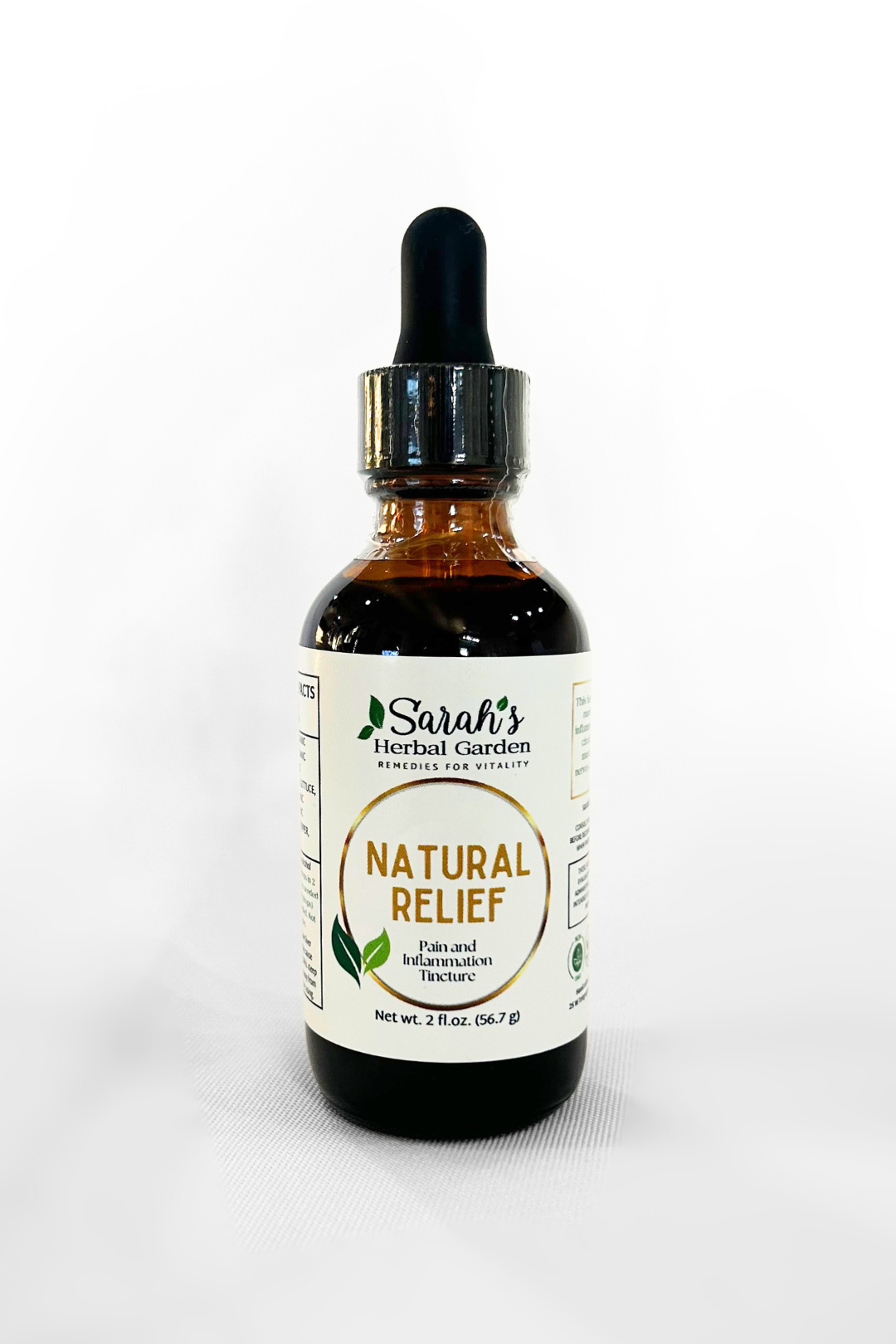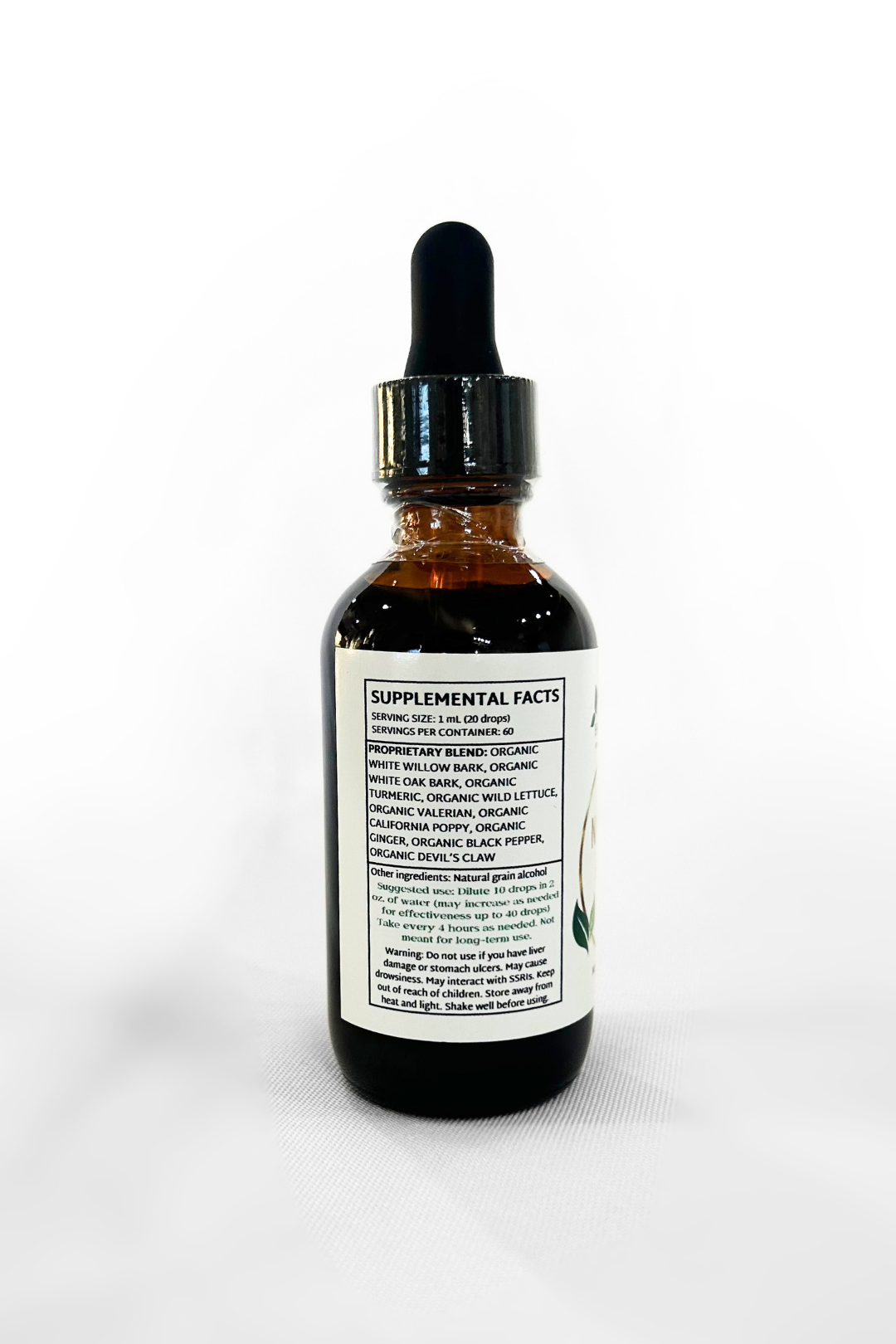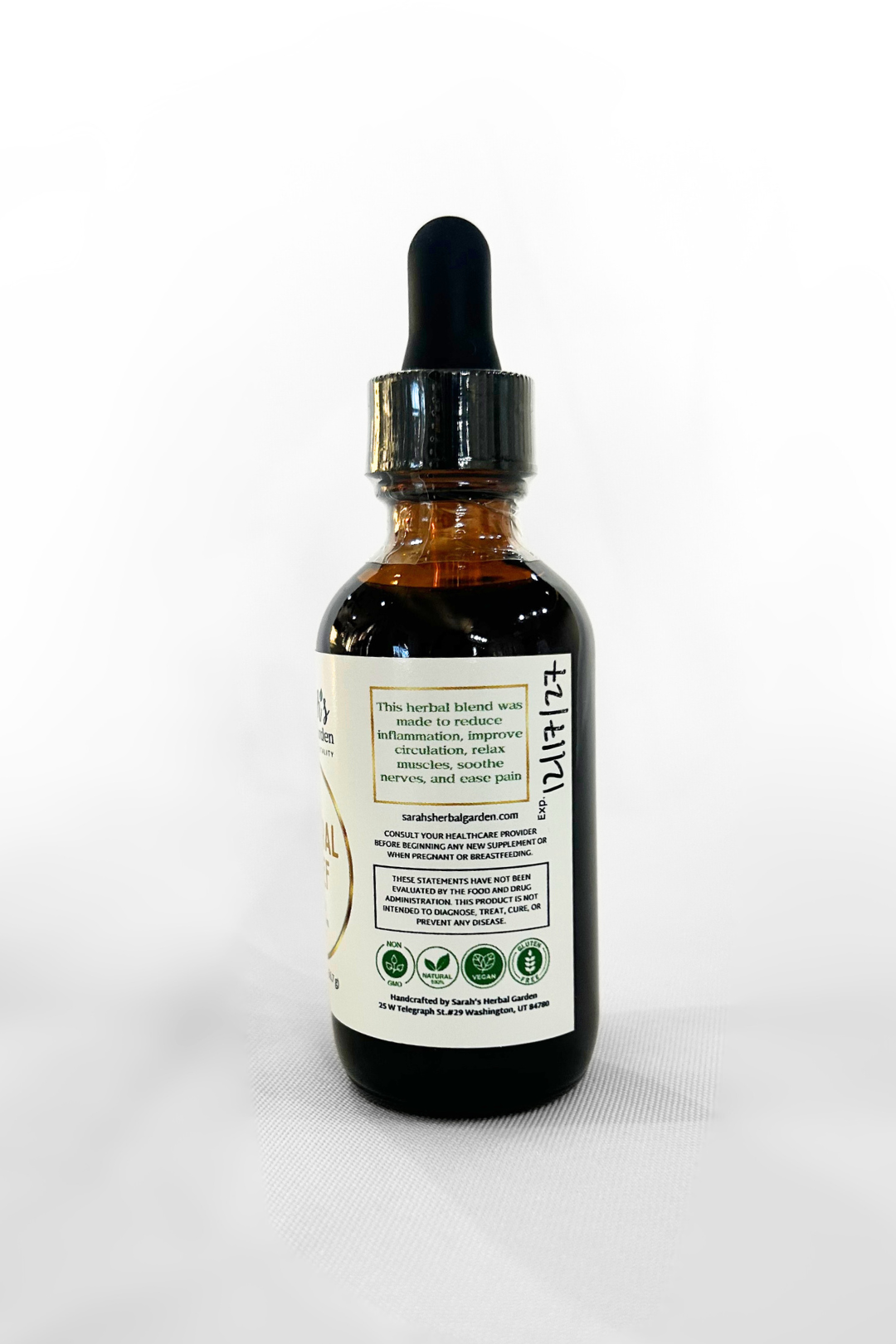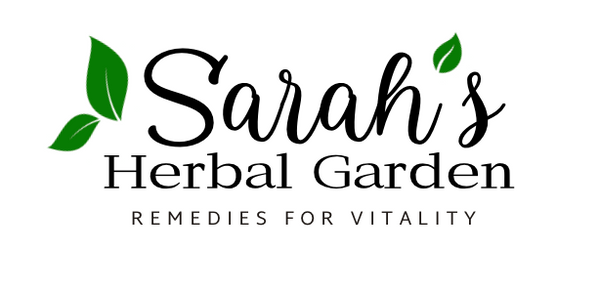Sarah's Herbal Garden
Natural Relief Tincture {For Pain and Inflammation}
Natural Relief Tincture {For Pain and Inflammation}
Couldn't load pickup availability
2 oz. Liquid Tincture
Suggested use: Dilute 10 drops in 2 oz. of water (may increase as needed for effectiveness up to 40 drops) Take every 4 hours as needed. Not meant for long-term use.
Herbal tinctures are concentrated liquid extracts made from medicinal herbs, and they offer an effective, natural way to manage pain. They work by delivering the active compounds of herbs directly into the bloodstream for faster absorption and relief. Here's how Natural Relief Tincture may help with pain:
1. Anti-Inflammatory Action
- Reduces Swelling: Many pain-related conditions are caused or exacerbated by inflammation. Tinctures made from anti-inflammatory herbs, like turmeric, ginger, and devil’s claw help reduce swelling and relieve associated pain.
- Targets Chronic Inflammation: Herbal tinctures provide long-term support for inflammatory conditions by reducing inflammatory markers in the body.
2. Analgesic Properties
- Natural Pain Relievers: Herbs like willow bark, valerian root, and wild lettuce contain compounds that directly interact with pain pathways, reducing the perception of pain.
3. Nervous System Support
- Calms Nerve-Related Pain: Herbs like California poppy soothe overactive nerves, reducing pain from conditions like neuropathy or sciatica.
- Regulates Pain Signals: Some herbs modulate neurotransmitters in the brain, helping to block or reduce pain signals.
4. Fast Absorption for Quick Relief
- Rapid Onset: Tinctures are absorbed through the digestive system, allowing the active compounds to enter the bloodstream quickly for faster pain relief compared to capsules or teas.
- Customizable Doses: The liquid form allows for precise dosage adjustments based on the severity of pain or individual needs.
5. Synergistic Effects
- Combination of Herbs: Many tinctures are blends of complementary herbs, enhancing their effectiveness.
- Supports Overall Health: In addition to pain relief, herbal tinctures address underlying issues like poor circulation, stress, or inflammation, offering holistic support.
7. Long-Lasting Relief
- Chronic Pain Management: Tinctures with herbs like devil’s claw and turmeric provide sustained anti-inflammatory effects, making them ideal for chronic inflammatory conditions.
- Supports Healing: By addressing inflammation and promoting circulation, herbal tinctures help reduce pain over time and support tissue repair.
Warning: Do not use if you have liver damage or stomach ulcers. May cause drowsiness. May interact with SSRIs. Keep out of reach of children. Store away from heat and light. Shake well before using.
These statements have not been evaluated by the Food and Drug Administration. This product is not intended to diagnose, treat, cure, or prevent any disease. Consult with healthcare provider if pregnant or breastfeeding, have an underlying health conditions, beginning an herbal supplement for the first time, or are taking other medications.
Share



Herbs used in this formula
White Willow Bark
White willow bark (Salix alba), often referred to as "nature's aspirin," is a natural remedy for pain relief. It has been used for centuries due to its potent analgesic, anti-inflammatory, and fever-reducing properties. The primary active compound in white willow bark is salicin, a chemical similar to aspirin (acetylsalicylic acid). Here’s how white willow bark helps alleviate pain:
1. Reduces Inflammation
- Anti-Inflammatory Properties: Salicin in white willow bark is converted into salicylic acid in the body, which helps reduce inflammation. This makes it effective for managing pain caused by conditions like arthritis, back pain, and injuries.
- Inhibits Inflammatory Pathways: It works by blocking cyclooxygenase (COX) enzymes, which are responsible for producing inflammatory compounds like prostaglandins.
2. Relieves Pain
- Natural Analgesic: Salicin acts similarly to aspirin, helping to alleviate mild to moderate pain. It is particularly effective for headaches, menstrual cramps, joint pain, and muscle soreness.
- Long-Lasting Relief: The pain-relieving effects of white willow bark are slower to onset but tend to last longer compared to synthetic pain relievers.
3. Reduces Fever
- Antipyretic Effect: White willow bark helps lower body temperature by reducing inflammation, making it useful for fever-related discomfort.
4. Eases Joint and Muscle Pain
- Supports Chronic Conditions: White willow bark is often used for chronic pain conditions like osteoarthritis, rheumatoid arthritis, and lower back pain due to its combined anti-inflammatory and analgesic effects.
- Improves Mobility: By reducing inflammation in joints and muscles, it helps improve mobility and reduce stiffness.
5. Soothes Headaches
- Effective for Migraines: Its anti-inflammatory properties target the vascular inflammation often associated with migraines and tension headaches.
- Reduces Trigger Factors: By lowering inflammation and pain sensitivity, white willow bark can reduce headache frequency and severity.
6. Provides Antioxidant Protection
- Combats Oxidative Stress: In addition to its pain-relieving properties, white willow bark contains flavonoids and polyphenols, which have antioxidant effects. These compounds help protect cells from damage caused by free radicals, which can contribute to chronic pain conditions.
White Oak Bark
White oak bark (Quercus alba) is a natural remedy traditionally used for its anti-inflammatory, astringent, and pain-relieving properties. It is particularly effective for addressing pain associated with inflammation, swelling, and skin irritation. Here's how white oak bark helps alleviate pain:
1. Reduces Inflammation
- Anti-Inflammatory Compounds: White oak bark contains tannins, flavonoids, and triterpenes, which reduce inflammation. By targeting inflammation, it helps relieve pain associated with conditions like arthritis, muscle soreness, and joint stiffness.
- Eases Swelling: Its anti-inflammatory effects also help reduce swelling that exacerbates pain in injuries or chronic conditions.
2. Provides Astringent Action
- Tightens Tissue: The high tannin content in white oak bark gives it strong astringent properties. This tightens and tones tissues, reducing inflammation and irritation in cases like hemorrhoids, sore throats, or skin wounds.
- Soothes Irritated Tissues: By reducing swelling and promoting tissue contraction, white oak bark alleviates pain caused by irritation or excessive fluid buildup.
3. Alleviates Skin and Wound Pain
- Heals and Protects: White oak bark is often used topically to soothe skin irritations such as cuts, burns, and rashes. Its tannins form a protective barrier that helps reduce pain and prevent infection.
- Calms Itching and Irritation: The astringent properties also ease itching and discomfort caused by eczema, bug bites, or other skin conditions.
4. Soothes Sore Throat and Mouth Pain
- Mouth and Throat Pain Relief: White oak bark can be used as a gargle or mouthwash to relieve pain and inflammation caused by sore throats, gum disease, or mouth ulcers.
- Reduces Swelling: Its astringent properties tighten the tissues in the throat or gums, reducing discomfort and inflammation.
5. Promotes Circulation and Recovery
- Improves Blood Flow: By reducing inflammation, white oak bark helps promote better circulation to affected areas, supporting faster recovery and pain relief.
- Supports Wound Healing: Enhanced circulation accelerates tissue repair, reducing pain associated with slow-healing wounds or injuries.
6. Relieves Digestive Discomfort
- Calms Gut Irritation: When taken internally, white oak bark reduces inflammation in the digestive tract, easing abdominal pain caused by conditions like diarrhea or irritable bowel syndrome (IBS).
- Astringent for the Gut: It reduces excess fluid in the intestines, relieving cramping and discomfort from digestive upset.
7. Acts as a Natural Antiseptic
- Prevents Infection: The tannins in white oak bark have antimicrobial properties, helping to reduce infection-related pain in wounds or inflamed tissues.
- Reduces Inflammatory Pain: By preventing infections, it indirectly reduces pain caused by prolonged inflammation.
Turmeric
Turmeric (Curcuma longa) is a well-known natural remedy for pain management, thanks to its active compound curcumin, which has potent anti-inflammatory, antioxidant, and analgesic properties. Here's how turmeric helps alleviate pain:
1. Reduces Inflammation
- Inhibits Inflammatory Pathways: Curcumin blocks inflammatory molecules such as cyclooxygenase-2 (COX-2)and lipoxygenase (LOX), as well as cytokines like TNF-alpha and interleukins. This reduces inflammation that causes pain in conditions like arthritis, injuries, and autoimmune disorders.
- Eases Chronic Inflammatory Conditions: Turmeric is particularly effective for managing chronic inflammatory pain, such as that associated with osteoarthritis, rheumatoid arthritis, and fibromyalgia.
2. Acts as a Natural Analgesic
- Modulates Pain Signals: Curcumin reduces the activity of pain receptors, providing relief from discomfort. It modulates the body's response to pain through interactions with neurotransmitters like serotonin and dopamine.
- Reduces Sensitivity: Regular use of turmeric can lower the body's sensitivity to pain stimuli, providing sustained relief.
3. Protects Against Oxidative Stress
- Antioxidant Properties: Curcumin neutralizes free radicals that contribute to tissue damage and pain. By reducing oxidative stress, turmeric protects cells and tissues from further damage and inflammation.
- Promotes Healing: Its antioxidant action accelerates tissue repair, reducing pain from injuries or surgery.
4. Improves Joint and Muscle Health
- Relieves Joint Pain: Curcumin reduces swelling and stiffness in joints, alleviating pain caused by arthritis and other joint conditions.
- Eases Muscle Soreness: Turmeric is effective for post-exercise muscle pain and general muscle soreness due to its anti-inflammatory effects.
5. Alleviates Nerve Pain
- Supports Nerve Health: Curcumin reduces inflammation in nerves and may alleviate neuropathic pain caused by conditions like sciatica, diabetes, or chemotherapy.
- Regenerates Nerve Tissue: Studies suggest curcumin may support nerve regeneration, helping to manage chronic nerve pain.
6. Supports Digestive Comfort
- Eases Abdominal Pain: Turmeric reduces inflammation in the digestive tract, alleviating cramping and discomfort caused by irritable bowel syndrome (IBS), colitis, or gastritis.
- Soothes Bloating: Its carminative properties relieve gas and bloating, further reducing abdominal pain.
7. May Reduce Headaches
- Eases Tension and Migraines: By reducing inflammation and improving blood flow, turmeric can alleviate certain types of headaches, including tension headaches and migraines.
8. Enhances Circulation
- Improves Blood Flow: Turmeric reduces blood clotting and improves circulation, helping to alleviate pain caused by poor blood flow, such as leg cramps or vascular-related pain.
Wild Lettuce
Wild lettuce (Lactuca virosa), sometimes referred to as "nature's opium," is a natural remedy for pain relief and relaxation. It has been used traditionally for its mild sedative and analgesic properties, making it effective for managing various types of pain and discomfort. Here's how wild lettuce helps with pain:
1. Natural Pain Reliever (Analgesic Properties)
- Lactucarium: Wild lettuce contains a milky sap called lactucarium, which is rich in compounds like lactucin, lactucopicrin, and sesquiterpene lactones. These compounds have analgesic properties, reducing the sensation of pain.
- Central Nervous System Effect: Lactucarium acts on the central nervous system to dull pain, similar to opiates but without the risk of addiction or significant side effects.
2. Sedative Effects
- Calms the Nervous System: Wild lettuce’s sedative properties help relax the body and mind, reducing pain perception and tension.
- Promotes Rest: Its ability to induce relaxation is particularly beneficial for pain-related sleep disturbances, such as those caused by chronic pain or injury.
3. Reduces Muscle and Joint Pain
- Antispasmodic Action: Wild lettuce relaxes smooth and skeletal muscles, helping to relieve pain from muscle cramps, spasms, and tension.
- Eases Joint Pain: Its anti-inflammatory properties can provide relief from arthritis or other joint-related conditions.
4. Alleviates Headaches and Migraines
- Relieves Tension: Wild lettuce reduces muscle tension and improves blood flow, which can help alleviate tension headaches and migraines.
- Soothes Nervous Overactivity: Its calming effects can reduce the severity and frequency of headaches triggered by stress or nerve tension.
5. Eases Nerve Pain
- Soothes Neuropathic Pain: Wild lettuce has been used traditionally to manage nerve pain, such as sciatica or neuropathy, by calming the nervous system and reducing inflammation.
6. Reduces Pain from Injuries
- Supports Healing: Its analgesic and anti-inflammatory properties make it useful for pain associated with minor injuries like sprains, strains, and cuts.
- Relieves Discomfort: Wild lettuce can help alleviate localized pain when applied topically as a poultice or infused oil.
7. Promotes Relaxation for Chronic Pain
- Improves Quality of Life: Chronic pain can lead to stress, insomnia, and fatigue. Wild lettuce’s sedative effects can improve relaxation and overall comfort for those dealing with long-term pain conditions.
- Reduces Dependency on Synthetic Painkillers: Wild lettuce may offer a natural alternative for mild to moderate pain management.
Valerian Root
Valerian root (Valeriana officinalis) is a herb traditionally used for its sedative, antispasmodic, and pain-relieving properties. While it is best known for promoting relaxation and improving sleep, it also plays a role in managing certain types of pain, particularly those related to tension, muscle spasms, and nerve-related issues. Here's how valerian root helps with pain:
1. Relieves Muscle Tension and Spasms
- Antispasmodic Effects: Valerian root helps relax smooth and skeletal muscles, making it effective for pain caused by muscle tension, cramps, or spasms.
- Eases Menstrual Cramps: Its ability to relax uterine muscles makes valerian root helpful for alleviating menstrual pain.
2. Calms the Nervous System
- Reduces Pain Perception: Valerian root interacts with gamma-aminobutyric acid (GABA) receptors in the brain, promoting a calming effect. This helps reduce the perception of pain, particularly in cases of chronic pain or nerve pain.
- Soothes Nerve-Related Pain: By calming overactive nerves, valerian root can alleviate conditions like sciatica, neuropathy, and tension headaches.
3. Alleviates Tension Headaches and Migraines
- Relaxes Blood Vessels: Valerian root promotes blood vessel relaxation, improving blood flow and reducing the vascular constriction that contributes to tension headaches and migraines.
- Relieves Stress-Induced Pain: Many headaches are triggered or worsened by stress. Valerian root’s sedative properties help manage stress, indirectly reducing headache frequency and severity.
4. Improves Sleep and Reduces Pain Sensitivity
- Supports Restorative Sleep: Chronic pain often disrupts sleep, and valerian root helps address this by promoting relaxation and improving sleep quality. Better sleep can reduce pain sensitivity and improve overall well-being.
- Calms Overactive Nerves: During rest, valerian root helps reduce overactive pain signals, particularly for chronic pain sufferers.
5. Reduces Inflammation
- Anti-Inflammatory Properties: While not its primary effect, valerian root contains compounds that may have mild anti-inflammatory effects, helping to reduce pain caused by inflammation in conditions like arthritis or muscle injuries.
6. Alleviates Emotional and Stress-Related Pain
- Relieves Psychosomatic Pain: Pain conditions exacerbated by stress, anxiety, or emotional distress (e.g., tension headaches, fibromyalgia) benefit from valerian root’s calming and mood-stabilizing effects.
- Reduces Muscle Tightness from Stress: Stress often leads to muscle stiffness and tightness, which can be alleviated with valerian root.
California Poppy
California poppy (Eschscholzia californica) is a natural remedy traditionally used for pain relief, relaxation, and sleep support. It is known for its mild sedative, antispasmodic, and analgesic properties, making it effective for managing various types of pain. Unlike its relative, the opium poppy, California poppy is non-addictive and gentle. Here’s how it helps with pain:
1. Acts as a Natural Analgesic
- Relieves Pain: California poppy contains alkaloids such as protopine and chelerythrine, which act on pain pathways in the nervous system to reduce pain perception.
- Gentle Pain Relief: It is particularly effective for mild to moderate pain, such as headaches, muscle aches, and chronic pain conditions.
2. Reduces Muscle Tension and Spasms
- Antispasmodic Effects: California poppy relaxes smooth muscles, making it helpful for pain caused by muscle tension, cramps, and spasms.
- Eases Menstrual Cramps: Its ability to relax uterine muscles makes it a useful remedy for menstrual pain.
3. Calms Nerve Pain
- Soothes Neuropathic Pain: By calming the nervous system, California poppy can alleviate nerve-related pain, such as sciatica or neuralgia.
- Reduces Hyperactivity: It helps quiet overactive nerve signals, which contribute to chronic nerve pain.
4. Promotes Relaxation and Reduces Stress-Related Pain
- Calms the Nervous System: The herb has mild sedative properties, reducing tension and pain caused or exacerbated by stress.
- Alleviates Psychosomatic Pain: Pain conditions linked to stress, such as tension headaches or fibromyalgia, benefit from its relaxing effects.
5. Supports Restful Sleep
- Improves Pain-Related Sleep Disturbances: Pain can disrupt sleep, which in turn exacerbates pain. California poppy’s sedative properties help promote restful sleep, reducing pain sensitivity and improving overall well-being.
- Promotes Recovery: Better sleep allows the body to repair and recover, addressing the underlying causes of pain.
6. Reduces Inflammation
- Anti-Inflammatory Properties: California poppy has mild anti-inflammatory effects, which help reduce swelling and pain associated with inflammatory conditions like arthritis or injuries.
7. Helps with Headaches and Migraines
- Relaxes Blood Vessels: By calming the nervous system and improving blood flow, California poppy can alleviate tension headaches and reduce the severity of migraines.
8. Supports Chronic Pain Management
- Non-Addictive Alternative: California poppy offers gentle pain relief without the risk of addiction, making it a suitable option for chronic pain conditions like fibromyalgia or arthritis.
- Reduces Dependence on Synthetic Painkillers: It can complement or replace pharmaceutical painkillers for mild to moderate pain.
Ginger
Ginger (Zingiber officinale) is a powerful natural remedy for pain management, known for its anti-inflammatory, analgesic, and antioxidant properties. It has been used in traditional medicine for centuries to treat various types of pain, including muscle soreness, joint pain, and menstrual cramps. Here’s how ginger helps with pain:
1. Reduces Inflammation
- Inhibits Pro-Inflammatory Enzymes: Ginger contains compounds like gingerol and shogaol, which block enzymes such as cyclooxygenase (COX) and lipoxygenase (LOX). These enzymes are responsible for producing inflammatory mediators like prostaglandins.
- Targets Chronic Inflammation: By reducing inflammation, ginger alleviates pain associated with conditions like arthritis, gout, and other inflammatory diseases.
2. Acts as a Natural Analgesic
- Relieves Pain Signals: Ginger interacts with pain pathways, reducing the sensation of pain in the body. It acts similarly to nonsteroidal anti-inflammatory drugs (NSAIDs) but without their side effects.
- Effective for Acute and Chronic Pain: Whether it’s temporary pain from exercise or ongoing discomfort from conditions like osteoarthritis, ginger helps relieve both.
3. Relieves Muscle Pain
- Reduces Exercise-Induced Muscle Soreness: Studies have shown that consuming ginger before or after physical activity reduces muscle pain and soreness.
- Improves Recovery: Its anti-inflammatory properties speed up recovery by reducing swelling and tissue damage.
4. Eases Joint Pain
- Effective for Arthritis: Ginger’s ability to reduce inflammation makes it especially beneficial for joint pain caused by osteoarthritis and rheumatoid arthritis.
- Improves Mobility: Regular use of ginger has been shown to enhance joint function and reduce stiffness.
5. Soothes Menstrual Cramps
- Relaxes Uterine Muscles: Ginger’s antispasmodic effects help ease menstrual cramps by reducing uterine contractions.
- Natural Alternative to NSAIDs: Research indicates that ginger can be as effective as ibuprofen for managing menstrual pain, without the risk of side effects.
6. Alleviates Headaches
- Relieves Migraine Symptoms: Ginger’s anti-inflammatory and vasodilatory effects can reduce the severity and frequency of migraines.
- Eases Tension Headaches: Its ability to relax muscles and improve circulation can alleviate tension-related headaches.
7. Calms Digestive Pain
- Relieves Abdominal Discomfort: Ginger soothes gastrointestinal pain caused by gas, bloating, and indigestion.
- Eases Nausea-Related Pain: Its ability to reduce nausea also alleviates discomfort caused by digestive issues or motion sickness.
8. Supports Nerve Pain Relief
- Soothes Neuropathy: Ginger’s anti-inflammatory properties help manage pain caused by nerve damage, such as sciatica or diabetic neuropathy.
- Protects Nerve Health: Its antioxidant compounds protect nerve cells from oxidative damage.
Black Pepper
Black pepper (Piper nigrum) is a natural remedy for pain relief, primarily due to its active compound piperine, which possesses anti-inflammatory, analgesic, and bioavailability-enhancing properties. Here’s a detailed look at how black pepper helps alleviate pain:
1. Anti-Inflammatory Effects
- Inhibits Inflammatory Pathways: Piperine blocks the activity of pro-inflammatory molecules like cytokines and prostaglandins. This reduces inflammation, which is a major cause of pain in conditions such as arthritis and injuries.
- Targets Chronic Inflammation: By lowering inflammation, black pepper can help manage long-term conditions like rheumatoid arthritis, gout, and fibromyalgia.
2. Natural Analgesic (Pain Reliever)
- Modulates Pain Signals: Piperine influences pain pathways in the nervous system, decreasing the perception of pain.
- Similar to NSAIDs: Piperine acts like mild nonsteroidal anti-inflammatory drugs (NSAIDs) by reducing the production of pain-causing chemicals without the side effects of synthetic drugs.
3. Enhances Absorption of Other Pain Relievers
- Boosts Bioavailability: Piperine enhances the absorption of pain-relieving compounds such as curcumin (from turmeric) and resveratrol. This makes other natural remedies or medications more effective at reducing pain.
- Synergistic Effects: Combining black pepper with other anti-inflammatory herbs like ginger or turmeric amplifies their pain-relieving effects.
4. Relieves Muscle and Joint Pain
- Eases Muscle Tension: Black pepper’s anti-inflammatory properties help reduce muscle pain caused by cramps, tension, or overuse.
- Supports Joint Health: By reducing swelling and inflammation, black pepper alleviates joint pain in conditions like osteoarthritis and rheumatoid arthritis.
5. Improves Circulation
- Enhances Blood Flow: Black pepper’s warming properties stimulate circulation, improving blood flow to areas affected by pain, such as sore muscles or injured tissues.
- Reduces Swelling: Improved circulation helps minimize swelling, which often contributes to pain.
6. Alleviates Nerve Pain
- Soothes Neuropathic Pain: Piperine interacts with the nervous system, calming overactive nerve signals associated with conditions like sciatica or diabetic neuropathy.
- Protects Nerve Cells: Its antioxidant properties help reduce oxidative damage, which can exacerbate nerve pain.
7. Supports Digestive Pain Relief
- Reduces Abdominal Discomfort: Black pepper stimulates the secretion of digestive enzymes, alleviating bloating, gas, and cramping.
- Eases Gut Inflammation: Its anti-inflammatory properties help soothe pain associated with gastrointestinal issues like irritable bowel syndrome (IBS).
8. Relieves Headaches and Migraines
- Tension Headache Relief: Black pepper’s muscle-relaxing and circulation-enhancing effects can reduce tension headaches.
- Reduces Migraine Severity: By improving blood flow and reducing inflammation, black pepper helps alleviate migraine symptoms.
Devil's Claw
Devil's claw (Harpagophytum procumbens) is a traditional herbal remedy known for its potent anti-inflammatory and analgesic properties. It is particularly effective in managing pain associated with inflammatory and degenerative conditions. Here's how devil's claw helps with pain:
1. Reduces Inflammation
- Anti-Inflammatory Compounds: Devil's claw contains harpagoside, a bioactive compound that inhibits inflammatory pathways, particularly the cyclooxygenase (COX-2) and lipoxygenase (LOX) enzymes responsible for producing pro-inflammatory molecules.
- Eases Chronic Inflammation: It is particularly effective in reducing inflammation in conditions like arthritis, gout, and tendonitis, which cause persistent pain.
2. Acts as a Natural Analgesic
- Pain Signal Modulation: Devil's claw reduces the perception of pain by interacting with pathways in the nervous system, similar to nonsteroidal anti-inflammatory drugs (NSAIDs).
- Effective for Chronic Pain: It is particularly beneficial for chronic conditions such as lower back pain, joint pain, and fibromyalgia.
3. Relieves Joint and Muscle Pain
- Supports Joint Health: Devil's claw alleviates pain, swelling, and stiffness in conditions like osteoarthritis and rheumatoid arthritis, improving joint mobility and overall quality of life.
- Eases Muscle Aches: Its anti-inflammatory and analgesic properties make it effective for sore or tight muscles.
4. Helps with Back Pain
- Proven Effectiveness for Lower Back Pain: Studies have shown that devil's claw significantly reduces chronic lower back pain, improving physical function and comfort.
- Reduces Muscle Tension: Its ability to relax muscles further contributes to pain relief in the back and spine.
5. Eases Tendon and Ligament Pain
- Supports Recovery from Strain: Devil's claw can reduce pain and inflammation in tendons and ligaments caused by overuse or injury.
- Helps with Tendonitis: Its ability to reduce inflammation makes it a natural remedy for conditions like Achilles tendonitis or tennis elbow.
6. Promotes Digestive Comfort
- Reduces Gastrointestinal Pain: Although less common, devil's claw’s anti-inflammatory effects can also help manage pain associated with digestive issues.



